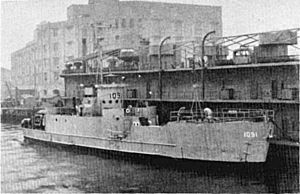USS LCI(L)-1091 facts for kids
class="infobox " style="float: right; clear: right; width: 315px; border-spacing: 2px; text-align: left; font-size: 90%;"
| colspan="2" style="text-align: center; font-size: 90%; line-height: 1.5em;" | 
|} The USS LCI(L)-1091 was a special kind of ship called a large landing craft. It was built for the United States Navy during World War II. These ships were used to carry soldiers and equipment to beaches during battles.
Unlike many other ships, LCI(L)-1091 did not get a fancy name. It was known only by its number.
Contents
| History | |
|---|---|
| Name |
|
| Builder | |
| Yard number | 344 |
| Laid down | 31 August 1944 |
| Launched | 14 September 1944 |
| Commissioned | 21 September 1944 |
| Decommissioned | 1955 |
| Honors and awards |
|
| History | |
| Name |
|
| Owner |
|
| Identification |
|
| Status | Currently preserved ashore at Eureka, CA. since December 2016. |
| General characteristics | |
| Class and type | LCI(L)-351-class large landing craft |
| Displacement | 236 t.(light), 264 t.(landing), 419 t.(loaded) |
| Length | 158 ft 5.5 in (48.298 m) |
| Beam | 23 ft 3 in (7.09 m) |
| Draft |
|
| Propulsion | 2 sets of 4 General Motors diesels, 4 per shaft, BHP 1,600, twin variable pitch propellers |
| Speed |
|
| Endurance | 4,000 miles at 12 knots, loaded, 500 miles at 15 knots; and 110 tons of fuel |
| Capacity | 75 tons cargo |
| Troops | 6 Officers, 182 Enlisted |
| Complement | 4 officers, 24 enlisted |
| Armament |
|
| Armor | 2" plastic splinter protection on gun turrets, conning tower, and pilot house |
Ship's Early Life and Service
The LCI(L)-1091 was built at the Defoe Shipbuilding Company in Bay City, Michigan. Its construction started on August 31, 1944. The ship was officially ready for duty, or commissioned, on September 21, 1944.
World War II Actions
The ship arrived in the Pacific Ocean near the end of the battle for Iwo Jima. It then took part in the Battle of Okinawa in 1945. This was a very important battle in the Pacific.
After the war, LCI-1091 helped clear mines around Japan. Mines are like underwater bombs that can harm ships. For its service in World War II, the ship earned two battle stars. These stars show that it took part in important military operations.
Post-War Duties and Reclassification
In 1946, LCI(L)-1091 was part of Operation Crossroads. This was a series of atomic bomb tests at Bikini Atoll. The ship helped support these tests.
On February 28, 1949, the ship's type was changed. It was reclassified as LSIL-1091. The "LSIL" stood for "Landing Ship, Infantry, Large."
Korean War Service
The ship stayed active during the Korean War. In 1951, it was changed into a special "Laboratory Ship." Its job was to help control diseases.
LSIL-1091 worked as an Epidemiological Control Ship. This means it helped fight diseases like malaria in Korea. From October 1951 to September 1952, it tested people for malaria at Koje-do.
After its service in Korea, the LSIL-1091 had another interesting role. It became one of the Navy's smallest aircraft carriers! It was used to launch target drones for anti-aircraft gun practice.
In 1955, the ship was officially taken out of service, or decommissioned, in Astoria, Oregon. For its work in the Korean War, LSIL-1091 earned four more battle stars.
After leaving the Navy, LSIL-1091 was sold. It was renamed Bering Sea. From 1961 to 1985, it worked as a cannery ship for salmon in Alaska. It helped process fish on the Yukon River.
In 1988, a veteran named Dr. Ralph Davis bought the ship. He renamed it Ten-Ninety-One. He moved it to Eureka, California. There, it was used for fishing albacore from 1995 to 2003.
The LCI(L)-1091 was used almost constantly for 65 years. It stayed in very good condition. In 2005, Dr. Davis gave the ship to the Humboldt Bay Naval Sea/Air Museum in Eureka. It became a museum ship and was opened to visitors.
The Humboldt Amateur Radio Club sometimes used the ship's original radio room. They would set up a special amateur radio station there. Over time, the ship needed more repairs.
By 2016, the Ten-Ninety-One was in poor shape. To keep it safe, it was moved onto land in Eureka, California. This way, it could be restored more easily.
Images for kids


